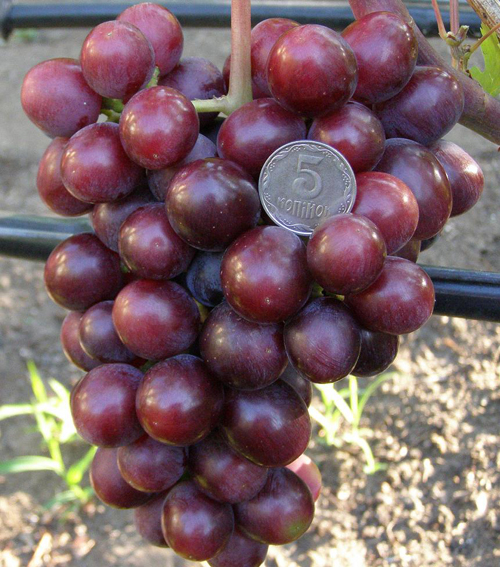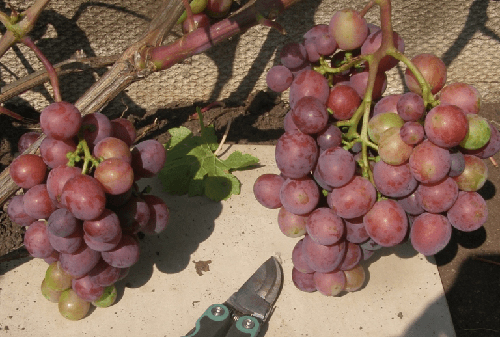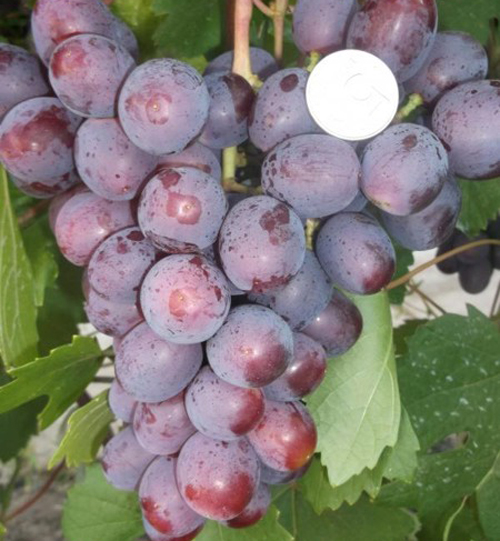Grape variety Gift Nesvetaya
Nesvetaya's gift is one of the excellent table grape varieties bred by the national breeder Yevgeny Pavlovsky from the Russian city of Novoshakhtinsk, located in the Rostov region. Born at the end of the 2000s, the hybrid form has recently successfully passed a full-fledged variety test, having taken a well-deserved place in the State Register of Breeding Achievements of the Russian Federation. By the way, this is not the first brainchild of Pavlovsky, which has earned official recognition and allowed for use throughout the country. In total, several dozen varieties and promising hybrid forms have been obtained as a result of many years of productive work. A truly outstanding result for a person who himself is engaged in crossing, growing, selecting and breeding hybrids, while in scientific institutions a similar amount of work is performed by entire teams.

Here it is necessary to make a reservation that Pavlovsky, like other amateur breeders, follows a rather easy path, using varieties with a functionally female type of flowering as mother forms. This makes it possible to simplify the procedure for preparing for crossing many times, which, in fact, leads to an acceleration of selection work in comparison with research institutions, where employees often work for a long time over each flower of bisexual varieties of grapes. This approach, although it allows you to quickly expand the ampelographic diversity due to new hybrid forms that are very attractive in appearance and taste, but at the same time rarely leads to the production of varieties with outstanding economic characteristics, such as resistance to disease and frost, and also possessing general unpretentiousness. ... This is probably why amateur varieties are most often registered in the State Register for the same amateur, not industrial use.
The Unlight's Gift was no exception. For its breeding, Evgeny Georgievich used almost one of the most popular varieties of grapes among folk breeders with a functionally female type of flower - Mascot, also known as Kesha-1. As a pollinator, one of the first hybrids of Pavlovsky himself was chosen under the name Beautiful girl... The mascot in this pair traditionally became responsible for the transfer of genes for large-fruited and high productivity, and Beauty endowed her descendant with great taste, rich color of bunches and early ripeness of the harvest. But the resistance to frost and fungal diseases remained at an average level or slightly above average.
The latter circumstance, however, does not prevent our hero from rapidly gaining the favor and sympathy of winegrowers, despite the relative high cost of scarce planting material. Both ordinary summer residents and farmers who cultivate grapes for commercial purposes are happy to give it a place on their plots. For everyone, he becomes one of the favorites, and excellent reviews about him further expand the excitement of interest in him.

Agrobiological characteristics of the variety
Plants are characterized by high vigor. The crown of a young shoot is glabrous, shiny, greenish with a bright bronze tint. Young leaves and the axis of the shoot of the Gift of Nesvetai are distinguished by a similar color. The fully developed leaf is green with reddish veins, of medium size, rounded, five-lobed with a strong degree of dissection between the lobes. The front side of the leaf is reticulate-wrinkled, on the back there is no pubescence. The upper side notches are deep, slit or lyre-shaped with parallel sides and a sharp bottom. The lower notches are similar in shape to the upper ones, but differ from them in less depth.The petiole notches are open lyre-shaped or vaulted with a pointed or flat bottom. The petioles contain anthocyanin pigmentation and are comparable in length to the length of the main vein. The teeth along the edge of the leaf blade of grapes are varied in size and shape - both triangular and saw-shaped, mostly with wide bases, barely curved edges and rounded tops. The flowers are bisexual, every year they are perfectly pollinated, the tendency to pea berries or strong loosening of the bunches is not noticed. Under normal growing conditions, the vine ripens well and practically to its entire length. Ripe shoots are brown with color in the area of the nodes, several shades darker than in internodes.
The bunches of the variety are very large, usually conical, with a density from medium to rather high, with an average weight of 600-700 grams, and a maximum of more than a kilogram. Despite the relatively dense clusters, the grapes in them are not deformed and are not damaged against each other. The combs are long, strong, green, but often with a lilac-reddish base. The berries of the Gift Unlight are remarkable in size and evenness, rounded-oval, weighing 8-12 grams, dark red-violet in color with a rich waxy bloom on the surface. The pulp has an excellent "marmalade" consistency, juicy-fleshy with a memorable harmonious taste and nutmeg aroma, which is very valuable for high-quality grapes. Freshly squeezed pink juice, has a good sugar content (18-20 g / 100 cubic cm) and low titratable acidity (4-5 g / cubic dm). Upon reaching full maturity, the glucose content with fructose increases by a few percentage points. The skin is moderately dense, eaten without problems. The seeds are medium in size, the berry contains a small number - usually one or two. Skin and bones do not have a significant negative effect on taste, and therefore they demonstrate very good tasting scores in the region of 8.9-9.0 points out of 10 possible.

The grape harvest is widely used for food purposes: both fresh and processed. Due to its high gastronomic and aesthetic characteristics, as well as its early maturity, it is in great demand among buyers on the market. Strong demand allows farmers to charge a higher price for it than for less marketable varieties, which, together with high yields, provides an excellent profitability of the variety. The owners of the household plots on which our hero grows are also very pleased with him, because regular bountiful harvests of tasty and fragrant "sunny berries" are enough both for food and for homemade preparations. At the same time, preservation turns out to be excellent in color and other organoleptic properties, due to which it is eaten with pleasure in winter. But the suitability of fresh grapes for long-distance transportation and storage in harvested form is not the strong point of the Unlight Gift. Under significant mechanical stress, the skin of the berries can be damaged, but it does not reliably protect the grapes from damage during storage. In this regard, it can be concluded that the variety is suitable only for local use in the growing region.
The first bunches in the south can be cut at the end of July. To achieve removable ripeness, it takes only some 95-100 days from the day of budding, which is why the variety is classified as ultra-early ripe. For varieties and hybrids with such a short growing season, 2100-2200 ° C of the sum of active temperatures is enough for the formation and ripening of the crop. This allows them to be cultivated in the broadest geographical framework, which, in fact, is demonstrated by our hero. Despite its recent appearance, this grape has already managed to establish itself in the middle zone of the European part of the country and even in some regions of Siberia, which is harsh in terms of climatic conditions. Naturally, at the same time, it grows remarkably well in traditional wine-growing areas.Almost everywhere they still prefer to cultivate it with shelter for the winter, however, if the frost resistance declared by the author is confirmed at -23 ° C, in the conditions of the south it will be quite possible to cultivate it on a trunk.

The variety is very productive. In the course of state variety testing, he showed an amazing result of 239 centners of bunches per hectare of plantings. In individual plantings, he quite copes with the load of 15-20 kilograms of grapes per adult, well-developed bush, without lengthening the ripening period and not showing other signs of overload. At the same time, Nesvetai's Gift still needs to be normalized, since a high percentage of fruitfulness of shoots and a significant number of large bunches capable of forming on them create the prerequisites for the weakening of plants by excessively abundant harvests, which threatens with potentially serious consequences up to their death in winter.
After the onset of removable maturity, the bunches can hang on the bushes for a long period of time, up to a month, if the weather permits. In this case, it is necessary to take into account a certain tendency to cracking of berries, which manifests itself in unfavorable seasons with a large amount of precipitation during the ripening period, or with a sharp change in soil moisture at this time. Insufficiently strong skin of berries is also not an obstacle for wasps, because of which these insects can damage ripe grapes. In addition, it has been noticed that birds are not averse to eating large, sweet berries of this variety, therefore, protection must be provided from them.
Agrotechnical features
From the point of view of the complexity of cultivation, Nesvetay's Gift shows itself as an ordinary grape that needs to follow standard agrotechnical procedures, and does not require any specific self-care. For planting, it is advisable to choose areas provided with heat, moisture and mineral nutrition on the plain, or on the slopes of expositions suitable for the culture. Naturally, it makes no sense to plant it in cold places, such as lowlands and northern slopes, on wetlands and damp lands, as well as where the level of groundwater is high. In regions with a limited amount of heat and the risk of insufficient crop maturation due to this, it is recommended to place plants in a wall culture, on the south side of various buildings or dense high fences and hedges. In this form, the grape bushes will be protected from cold winds, and the amount of active temperatures they receive and the duration of the frost-free period will slightly increase. The variety does not impose fundamental requirements on the mechanical composition and fertility of soils, however, like many other varieties, it responds positively to the application of fertilizers and various kinds of feeding during the growing season.
The area of food for vigorous bushes is allocated sufficient so that they do not have to compete fiercely with neighbors for soil moisture, sunlight and nutrients. In this case, you will need at least 4.5-5 sq. meters, which, with a row spacing of 2.5 meters, will mean the distance between bushes in a row is 1.75-2 meters. Vineyard laying can be carried out both with own-rooted cuttings and grafted grape seedlings. The cuttings of Nesvetai's Gift take root quite easily, so even not the most experienced grower can propagate it in this way. However, this option can be implemented only in areas not infected with root phylloxera, due to which unstable varieties die within 5-6 years after planting. Where this malicious soil pest has already firmly established itself, there is nothing left but to use seedlings based on phylloxera-resistant rootstock for planting. This method leads, as a rule, to a delay in the entry of plants into fruiting by an average of a year, but it is the only possible one in regions infected with root aphids.
The first clusters on young bushes appear, depending on the method of reproduction, in the second or third year from the moment of planting, which means that it is necessary to start the formation of plants without putting this issue on the back burner. If the climate permits, then the ideal option for grapes would be to grow it on a trunk with a large supply of perennial wood, in which plastic substances accumulate in significant quantities, and then are used to form an abundant large-fruited harvest. However, with this pattern of bush management, there is a natural limitation - the vine is not able to withstand frosts below -23 ° C. Therefore, in most regions of cultivation of the variety, except for the extreme south with its mild winters, Nesvetaya's Gift is sheltered for the winter, which means that the standard formation is inappropriate in this case. With a covering culture, the plants are formed in such a way that, without damaging the vine, they can be removed from the trellis for warming before the cold season. Most often, in these cases, they use squat options like a multi-arm fan, an inclined cordon or a Guyot pattern. Shelter is carried out with land in areas with an average frost hazard, or with improvised organic insulation (straw, peat, spruce branches, reeds, etc.) in places where the winter cold is rampant. In the first case, earthen shelters can be replaced with mini-greenhouses, like film tunnels used in vegetable growing, and in the second, the same film, or roofing material will be required to waterproof the insulation and prevent it and the covered vine from getting wet with thawed moisture. Well-ripened dry shoots under a good shelter are able to withstand very harsh winters, and when wet, the winter hardiness of plants is significantly reduced due to the massive damping of the eyes.
Special attention should be paid to the spring pruning of grape bushes that have entered fruiting and their subsequent normalization by shoots and harvests, since the highly productive Gift of the Unsvetaya is prone to regular overloads, and the associated negative consequences for itself. In the spring, only 30-40 eyes are left on the bush due to the almost complete absence of sterile shoots that will need to be removed. The average length of the fruit arrows is 6-8 buds. After the beginning of the growing season, single shoots break off on which there are no inflorescences, as well as weak vines, "doubles", "tees"
The fight against fungal diseases of grapes is usually of medium intensity. It will be enough for the variety to provide two or three complex preventive treatments with fungicides at the initial stages of the growing season, primarily before and after flowering, in order to then calmly react pointwise to rare outbreaks of pathogen development. In addition, a good preventive result is shown by the thinning of the crown of the bushes and the clarification of the fruit zone, as a result of which the conditions for the development of pathogens are significantly deteriorating. Against wasps and birds, the most effective way is to place the bunches in individual protective bags, where they will be safe until the very harvest.
To prevent cracking of the berries, it is advisable to take care of regulating the water balance of the soil and preventing its excessive drying out, becauseit is precisely because of the abrupt change of drought with torrential rains that this problem is most often actualized. The easiest option would be to mulch the soil abundantly with organic matter, but the most effective is regular abundant watering of the grapes, which, moreover, will have the most favorable effect on the yield and quality of the fruits of the magnificent Gift of Nesvetai.









My vineyard is not very large - so far I only grow 23 varieties. I like everyone, but I have a special attitude to this. The variety never fails: since it belongs to the early maturing, it always manages to ripen, and in the conditions of the Middle Volga, not everyone succeeds. The brushes are large, dense, there are never "peas" - pollination is always excellent; the berries are bright - we have a large difference between day and night temperatures, and this contributes to good coloring and the accumulation of sugars; the taste of the grapes is excellent - there are "fruit notes", the pulp is not watery; the bush perfectly holds the load and does not require rationing. The only problem is that the vine needs to be removed from the support and covered for the winter, but this grape is worth the effort.